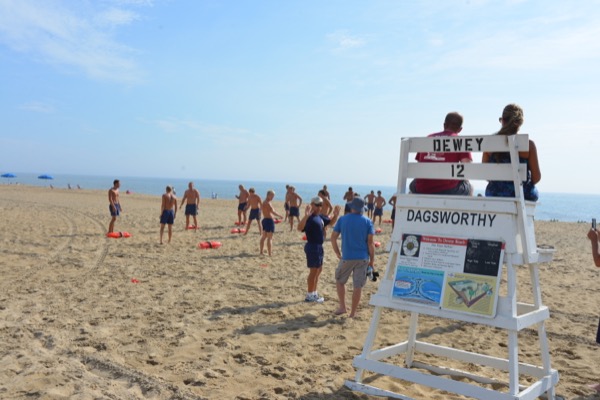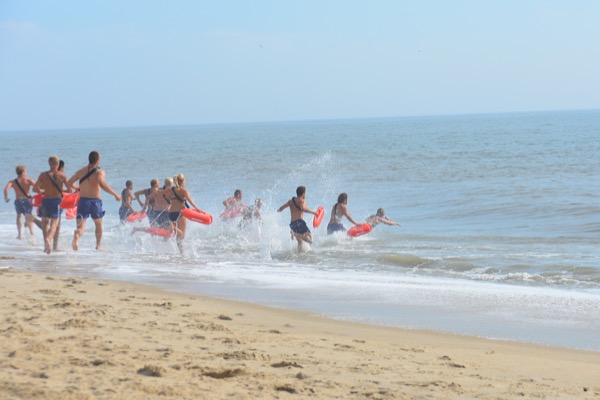Rip Current Awareness
Delaware Sea Grant, partners hold workshop on rip current safety and awareness
2:33 p.m., June 10, 2015--Delaware boasts some of the most beautiful beaches in the country. Whether beachgoers are boogie boarding, swimming or simply soaking up rays, beach safety is an important part of enjoying a day by the ocean.
For over a decade, Delaware Sea Grant (DESG), which is housed in the University of Delaware’s College of Earth, Ocean, and Environment, has been part of a national movement to educate beachgoers about the hazards of rip currents — strong, narrow currents that can pull even the strongest swimmers away from shore.
Campus Stories
From graduates, faculty
Doctoral hooding
According to the United States Lifesaving Association (USLA), rip currents are responsible for 100 drownings every year. Rip currents are also the cause of 75 percent of all rescues by lifeguards.
This year marks the 10th anniversary of the Break the Grip of the Rip program, a collaborative educational initiative between USLA and the National Oceanic and Atmospheric Administration (NOAA), including the National Weather Service (NWS) and Sea Grant programs.
Over the years, participating Sea Grant programs like DESG have worked with local beach patrols to track and predict rip current activity and to teach beachgoers how to spot rip currents, why they’re dangerous and what to do if swimmers get caught in one.
According to Wendy Carey, marine advisory specialist with DESG, the program has seen great success in reaching beachgoers across the country. For example, rip current advisories are now included in major media news and daily weather reports as a result of increased awareness.
“That is important,” Carey said. “Before the Break the Grip of the Rip program, people called rip currents by all different names, and there wasn’t a lot of information warning the public about them. Delaware Sea Grant worked with USLA and NWS and Sea Grant programs under NOAA to standardize the message and raise awareness about rip currents.”
“The fact that rip current forecasts are now a common part of daily weather reports is a testament to the success of that effort,” Carey continued.
In conjunction with Rip Current Awareness week, which runs June 7-13, DESG is hosting a workshop bringing NWS, research scientists and beach patrols from New Jersey, Delaware and Maryland together to discuss ongoing strategies for rip current forecasting and communicating the hazard message to the public.
The workshop will include informative presentations by representatives from UD, the Delaware Department of Natural Resources and Environmental Control, Beebe Healthcare, Delaware and New Jersey Sea Grant programs, Stevens Institute of Technology and National Weather Service offices in Mount Holly, New Jersey, and Wakefield, Virginia. Presentations will be followed by discussion of the factors that influence rip currents and methods for connecting beach patrols and NWS.
One strategy is to implement Decision Support conference calls — daily conference calls made between beach patrols and NWS stations to provide real-time feedback and verification about rip current conditions and rescues from local beach patrols.
“Verification from lifeguards about the presence of rip currents and the number of rescues made daily is important for gathering data and understanding rip currents, so we can learn how to better predict them,” Carey said.
Walt Drag, a marine weather forecaster and the rip current lead at the NWS office in Mount Holly, will conduct a live Decision Support conference call with local beach patrols during the workshop on Thursday.
Participants at the workshop will also discuss and evaluate the forecast process and messaging products.
With the 10th anniversary of the Break the Grip of the Rip program and Rip Current Awareness week, Carey stated that the workshop is a timely opportunity to evaluate the progress made in rip current forecasting, communication and awareness, and to discuss opportunities to make the field stronger.
“Ultimately, we want people to know that you can have fun at the beach, and that part of that is being aware of hazards like rip currents and how to deal with them,” Carey said. “The best advice for beach-goers is to swim at a lifeguarded beach and speak with the on-duty guard about any possible hazards or risks for the day.”
For more information regarding rip currents, see the NOAA and USLA rip current websites.
Article by Caren Fitzgerald












